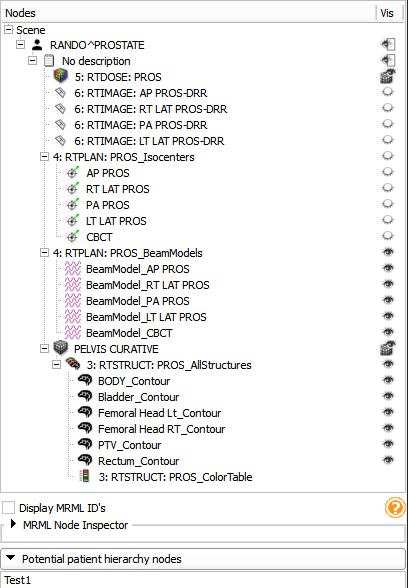Difference between revisions of "Documentation/Nightly/Modules/SubjectHierarchy"
From Slicer Wiki
m |
(Overhaul step 1) |
||
| Line 8: | Line 8: | ||
{{documentation/{{documentation/version}}/module-introduction-start|{{documentation/modulename}}}} | {{documentation/{{documentation/version}}/module-introduction-start|{{documentation/modulename}}}} | ||
{{documentation/{{documentation/version}}/module-introduction-row}} | {{documentation/{{documentation/version}}/module-introduction-row}} | ||
| − | This work is part of the SparKit project, funded by An Applied Cancer Research Unit of Cancer Care Ontario with funds provided by the Ministry of Health and Long-Term Care and the Ontario Consortium for Adaptive Interventions in Radiation Oncology (OCAIRO) to provide free, open-source toolset for radiotherapy and related image-guided interventions.<br> | + | :'''Title''': Subject Hierarchy |
| − | + | :'''Author''': Csaba Pinter (PerkLab, Queen's University)<br> | |
| − | Contact: Csaba Pinter, <email>pinter@ | + | :'''Acknowledgements''': This work is part of the SparKit project, funded by An Applied Cancer Research Unit of Cancer Care Ontario with funds provided by the Ministry of Health and Long-Term Care and the Ontario Consortium for Adaptive Interventions in Radiation Oncology (OCAIRO) to provide free, open-source toolset for radiotherapy and related image-guided interventions.<br> |
| − | + | :'''Contact''': Csaba Pinter, <email>csaba.pinter@queensu.ca</email><br> | |
{{documentation/{{documentation/version}}/module-introduction-row}} | {{documentation/{{documentation/version}}/module-introduction-row}} | ||
| Line 24: | Line 24: | ||
<!-- ---------------------------- --> | <!-- ---------------------------- --> | ||
{{documentation/{{documentation/version}}/module-section|Module Description}} | {{documentation/{{documentation/version}}/module-section|Module Description}} | ||
| − | The {{documentation/modulename}} module | + | The {{documentation/modulename}} module acts as a central data-organizing point in Slicer. All DICOM data is autmatically added to the tree. Non-DICOM data can be parsed if loaded from a local directory structure, or has to be manually added (non-SH nodes are the ones on the bottom with no icons). |
| + | Subject hierarchy nodes provide features for the underlying data nodes, including cloning, bulk transforming, bulk show/hide, type-specific features, and basic node operations such as delete or rename. Additional plugins can provide other type-specific features and general operations, see [[Documentation/Labs/SubjectHierarchy|Subject hierarchy labs page]] | ||
<!-- ---------------------------- --> | <!-- ---------------------------- --> | ||
| Line 31: | Line 32: | ||
{| class="wikitable" | {| class="wikitable" | ||
| | | | ||
| − | |||
* Load DICOM data and need to see in the same hierarchy | * Load DICOM data and need to see in the same hierarchy | ||
| − | * | + | * Visualize and bulk-handle lots of data nodes loaded from disk |
| − | * Transform whole study ( | + | * Easy show/hide of branches of displable data |
| + | * Transform whole study (any branch) | ||
* Export DICOM data (coming soon) | * Export DICOM data (coming soon) | ||
| − | |||
| − | |||
* Edit DICOM tags (coming soon) | * Edit DICOM tags (coming soon) | ||
| + | * Create contour from labelmap or model (currently supported only in the [[Documentation/{{documentation/version}}/Extensions/SlicerRT|SlicerRT extension]] | ||
<!-- ---------------------------- --> | <!-- ---------------------------- --> | ||
| Line 47: | Line 47: | ||
{{documentation/{{documentation/version}}/module-section|How to}} | {{documentation/{{documentation/version}}/module-section|How to}} | ||
| − | ; Create | + | ; Create new Patient/Subject from scratch |
| − | : | + | : Right-click on the top-level item 'Scene' and select 'Create new subject' |
| − | |||
| − | |||
| − | ; Create | + | ; Create new generic Subject hierarchy node from scratch |
| − | : | + | : Right-click on an existing node and select 'Create generic child node'. The level of the child node will be one under the parent node if available (e.g. 'Patient' / 'Subject' -> 'Study', 'Subseries' -> 'Subseries'). |
| − | ; | + | ; Rename Subject hierarchy node |
| − | : Right-click on | + | : Right-click on the node and select 'Rename', or double-click the name of a node |
| − | ; | + | ; Apply transform on node or branch |
| − | : | + | : Double-click the cell of the node or branch to transform in the column named 'Tr', then set the desired transform. If the column is not visible, check the 'Transforms' checkbox under the tree |
| − | ; Create | + | <br> |
| − | : | + | ; Contour-specific features (requires [[Documentation/{{documentation/version}}/Extensions/SlicerRT|SlicerRT extension]]): |
| + | ;: Create contour from scratch | ||
| + | :: In Contours module select 'Create new Contour' in the contour selector drop-down to create a new contour | ||
| + | :: In Subject Hierarchy module drag&drop new contour from 'Potential subject hierarchy nodes' list to under a contour set in the tree | ||
| + | :: The default representation is an empty Ribbon model. It can be converted to Indexed labelmap in the Contours module and then the labelmap '''can be edited in the Editor module''' | ||
| − | ; | + | ;: Create contour from labelmap volume or model |
| − | : | + | :: In Subject Hierarchy module drag&drop the existing representation (labelmap or model) from the non-Subject hierarchy nodes (on the bottom of the tree without role icons) to under a contour set in the tree. This way an encapsulating Contour node gets created and associated to the corresponding color table |
| − | ; | + | ;: Create new Contour set from scratch |
| − | : | + | :: Right-click on an existing Study node and select 'Create child contour set'. This menu item is only available for Study level nodes |
| [[File:SlicerRT_0.11_PatientHierarchy_ProstateEntLoaded.png|thumb|408px| Subject hierarchy module GUI]] | | [[File:SlicerRT_0.11_PatientHierarchy_ProstateEntLoaded.png|thumb|408px| Subject hierarchy module GUI]] | ||
Revision as of 22:17, 23 September 2014
Home < Documentation < Nightly < Modules < SubjectHierarchy
|
For the latest Slicer documentation, visit the read-the-docs. |
Introduction and Acknowledgements
| |||||||
|
Module Description
The SubjectHierarchy module acts as a central data-organizing point in Slicer. All DICOM data is autmatically added to the tree. Non-DICOM data can be parsed if loaded from a local directory structure, or has to be manually added (non-SH nodes are the ones on the bottom with no icons). Subject hierarchy nodes provide features for the underlying data nodes, including cloning, bulk transforming, bulk show/hide, type-specific features, and basic node operations such as delete or rename. Additional plugins can provide other type-specific features and general operations, see Subject hierarchy labs page
Use Cases
TutorialsNone specifically for Subject Hierarchy yet How to
|
Panels and their use
- Subject hierarchy tree (top)
- Contains all the objects in the Subject hierarchy in a tree representation.
- The only items that exist in the tree before importing any data are the default contour set and its corresponding color table, which facilitates Contour node creation without having any DICOM data imported
- MRML Node Inspector (closed drop-down panel under the tree)
- Displays the attributes of the currently selected Subject hierarchy node. Can be edited by double-clicking on an attribute name or value
- Potential subject hierarchy nodes list
- List of nodes that are currently outside the subject hierarchy, but can be added. Nodes are listed in this list if there is at least one plugin that can do the adding of that node.
Similar Modules
N/A
References
- Manual editing of contours can be done in the Contours module
Information for Developers


